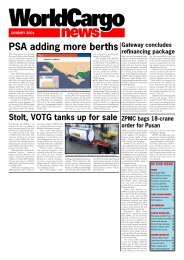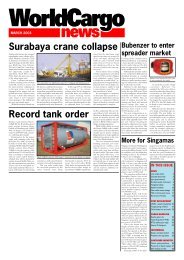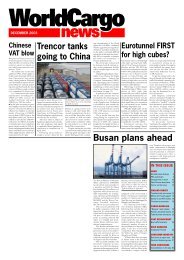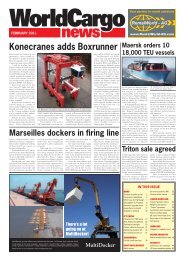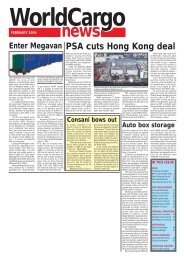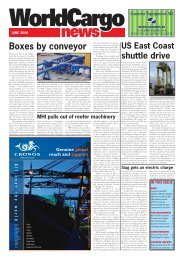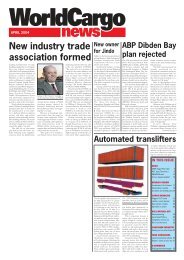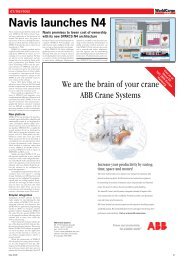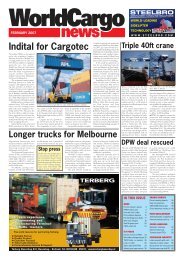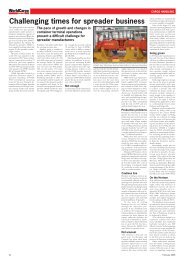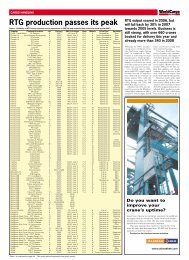US-built box crane - WorldCargo News Online
US-built box crane - WorldCargo News Online
US-built box crane - WorldCargo News Online
Create successful ePaper yourself
Turn your PDF publications into a flip-book with our unique Google optimized e-Paper software.
NORTH AMERICA: WEST COAST PORT DEVELOPMENT<br />
<strong>WorldCargo</strong><br />
news<br />
age area increased, a throughput of<br />
600,000TEU/year will be possible.<br />
The efforts of both Vancouver and<br />
Fraser to expand capacity are being<br />
matched by the Canadian Pacific Railway<br />
(CPR), which is spending C$160<br />
mill on 25 projects that will enable it to<br />
run an additional four 100-car unit trains/<br />
day on its transcontinental system, a 12<br />
per cent increase over current capacity.<br />
Boosting <strong>box</strong>es<br />
With nearly 1.7 mill TEU handled last<br />
year, Vancouver, BC is pulling abreast of<br />
cross-border rivals Seattle and Tacoma,<br />
each with about 1.8 mill TEU in 2004.<br />
Vancouver can also still expand Roberts<br />
Bank. Seattle, on the other hand, has run<br />
out of room unless it wishes to convert<br />
its Pier 90/91 complex to containers, and<br />
this seems unlikely given the strength of<br />
local resident opposition.<br />
However, capacity at Seattle has been<br />
boosted by expansion of Terminals 18 and<br />
46, while Terminal 25 has recently been<br />
reopened following <strong>US</strong>$20 mill worth of<br />
reconstruction work and the installation<br />
of three Paceco Portainers moved up from<br />
Long Beach. The work allows Matson<br />
Navigation to shift its operations from T18<br />
to T25, thus opening up room at T18<br />
where additional post-panamax <strong>crane</strong>s are<br />
to be delivered next year. The refinements,<br />
as well as Southern California traffic diversion,<br />
helped push Seattle’s container<br />
volume up 25 per cent in the first half of<br />
the year. It expects to match or exceed<br />
last year’s record of 1.78 mill TEU by the<br />
end of this year.<br />
Tacoma moved ahead of Seattle in<br />
BNSF cleans up<br />
BNSF Railway is installing new technology<br />
to provide cleaner air and more efficient<br />
freight movement. “Rail has long<br />
been the most efficient means humankind<br />
has ever created for moving freight<br />
overland,” remarked John Lanigan, EVP<br />
and chief marketing officer. The new<br />
generation of equipment will help improve<br />
Southern California’s air quality<br />
and its economy.”<br />
On the list is Green Goat, a hybrid<br />
switch engine that utilises a system of a<br />
microturbine and batteries. According to<br />
BNSF, currently there are only four LNG<br />
locos in the <strong>US</strong> and they are all located at<br />
its Los Angeles facility, Hobart Yard.<br />
Lanigan says that, subject only to successful<br />
trials and testing, BNSF’s Southern<br />
California International Gateway<br />
intermodal facility (SCIG) will use “only<br />
LNG-powered locomotives for railcar<br />
switching, only LNG-powered yard tractors<br />
and only electrically-powered <strong>crane</strong>s.”<br />
BNSF expects the SCIG to remove<br />
millions of miles of truck traffic from<br />
nearby congested freeways, with concomitant<br />
major air quality impacts. It is<br />
hoped the SCIG will provide direct access<br />
to the Alameda Corridor and will<br />
enable it to reach its potential in terms of<br />
train capacity.<br />
BNSF is collaborating with Parsec and<br />
Sound Energy Solutions to acquire and<br />
deploy LNG-powered yard tractors,<br />
which are being <strong>built</strong> by Kalmar Industries<br />
(Ottawa units). Using LNG yard tractors,<br />
it says, will reduce NOx and PM<br />
emissions by 95 per cent compared to a<br />
standard off-road diesel tractor.<br />
BNSF has already begun to install the<br />
SmartStart engine idle reduction system<br />
from ZTR Control Systems on locomotives<br />
in Southern California. It is promoting<br />
the key benefits of SmartStart as including<br />
a reduction in the fuel burned by<br />
automatically shutting down idling locomotives,<br />
and a reduction in harmful gas,<br />
PM and noise emissions.<br />
Meanwhile, both BNSF and UP have<br />
provided traffic data for a simulation study<br />
carried out by the Washington state Port<br />
of Vancouver to ascertain the best option<br />
for a third rail access. The study has indicated<br />
that the existing BNSF/ Vancouver<br />
rail network is already experiencing congestion<br />
during peak train volume levels.<br />
Currently, a daily average of 27 delays<br />
of more than 30 mins was recorded and<br />
nearly half (45 per cent) of the delays involved<br />
port trains even though port traffic<br />
accounts for only 5.2 per cent of the<br />
rail network total. ❏<br />
container traffic last year, with over 1.8<br />
mill TEU handled. This number may<br />
move to 2 mill TEU now that Evergreen<br />
and K-Line have settled into new terminals,<br />
to be followed shortly by Yang Ming.<br />
The port is fitting its own fleet of 30 straddle<br />
carriers with diesel oxidation catalysts<br />
this year using federal and local grants.<br />
The work is expected to reduce the machines’<br />
PM emissions by up to 50 per cent<br />
(Ever Greener on p26).<br />
Mostly strads<br />
Although K-Line’s new terminal uses<br />
RTGs in the storage yard, straddle carriers<br />
are used to move containers between<br />
the yard and Tacoma’s North Intermodal<br />
rail facility. They will also be used by Yang<br />
Ming when that carrier starts up operations,<br />
leaving Maersk Sealand, which uses<br />
the South Intermodal Yard, as the port’s<br />
only non-straddle carrier operator.<br />
Smaller ports dream big<br />
In California the small ports of San Diego<br />
and Hueneme have taken a number<br />
of customers from LA/LB, principally automobile<br />
and fruit handlers. Next year<br />
Toyota Logistics Service will pull one<br />
operation from Long Beach and move it<br />
to the privately-run Port of Benicia on<br />
San Francisco Bay.<br />
This will open up a 30-acre facility at<br />
Long Beach that may be merged with the<br />
nearby SSA Terminal, used by MSC, Zim<br />
and CMA CGM, to expand that complex<br />
to 200 acres. Toyota will retain a 144-<br />
acre receiving and processing facility at<br />
Long Beach as well as a similar facility<br />
operated at Portland, Oregon.<br />
Moving cargo at<br />
The initial results of the PierPass Program in LA/LB have exceeded expectations, with night<br />
hours gate traffic reaching as much as 30 per cent of daily demand<br />
Both San Diego and Hueneme have<br />
been expanding their capacity to handle<br />
additional cargo, and both have acquired<br />
harbour mobile <strong>crane</strong>s to help move deck<br />
TM GE Automation Systems, LLC<br />
containers to and from reefer ships. Another<br />
smaller West Coast port investing<br />
in lifting capacity is Everett, Wa where<br />
Boeing Company is changing the way it<br />
TMEIC GE is the world’s largest supplier of <strong>crane</strong><br />
control systems for container shipments worldwide.<br />
We produce powerful systems to promote efficiency,<br />
reduce maintenance, and function without fail in even<br />
the most demanding environments.<br />
• The Maxspeed control<br />
system diagnostics reduce<br />
<strong>crane</strong> maintenance and<br />
optimize availability<br />
• Provides continuous and on<br />
line measurement of <strong>crane</strong><br />
utilization and productivity<br />
• Integration of real time<br />
<strong>crane</strong> and container<br />
logistics to support asset<br />
planning and deployment<br />
• System integration of<br />
other yard management<br />
assets such as GPS (Global<br />
Positioning Systems) and<br />
OCR (Optical Character<br />
Recognition) subsystems<br />
to permit real time container<br />
tracking and location within<br />
the yard<br />
• The Maxview<br />
vision system and<br />
auto-navigational<br />
subsystems help assure<br />
consistent operating<br />
productivity and<br />
increase safety<br />
1501 Roanoke Blvd. • Salem VA, 24153 <strong>US</strong>A<br />
TEL: +1-540-387-5741 FAX: +1-540-387-7060<br />
www.tmge.com<br />
.<br />
September 2005 27



